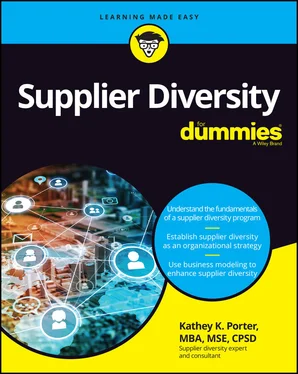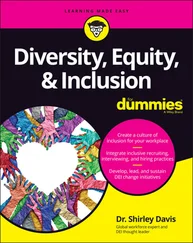Kathey K. Porter - Supplier Diversity For Dummies
Здесь есть возможность читать онлайн «Kathey K. Porter - Supplier Diversity For Dummies» — ознакомительный отрывок электронной книги совершенно бесплатно, а после прочтения отрывка купить полную версию. В некоторых случаях можно слушать аудио, скачать через торрент в формате fb2 и присутствует краткое содержание. Жанр: unrecognised, на английском языке. Описание произведения, (предисловие) а так же отзывы посетителей доступны на портале библиотеки ЛибКат.
- Название:Supplier Diversity For Dummies
- Автор:
- Жанр:
- Год:неизвестен
- ISBN:нет данных
- Рейтинг книги:4 / 5. Голосов: 1
-
Избранное:Добавить в избранное
- Отзывы:
-
Ваша оценка:
- 80
- 1
- 2
- 3
- 4
- 5
Supplier Diversity For Dummies: краткое содержание, описание и аннотация
Предлагаем к чтению аннотацию, описание, краткое содержание или предисловие (зависит от того, что написал сам автор книги «Supplier Diversity For Dummies»). Если вы не нашли необходимую информацию о книге — напишите в комментариях, мы постараемся отыскать её.
Supplier Diversity For Dummies,
Supplier Diversity For Dummies
Supplier Diversity For Dummies — читать онлайн ознакомительный отрывок
Ниже представлен текст книги, разбитый по страницам. Система сохранения места последней прочитанной страницы, позволяет с удобством читать онлайн бесплатно книгу «Supplier Diversity For Dummies», без необходимости каждый раз заново искать на чём Вы остановились. Поставьте закладку, и сможете в любой момент перейти на страницу, на которой закончили чтение.
Интервал:
Закладка:
Compliance with the law
Although simply staying out of trouble was the prevailing reason for diversity measures in the beginning, it’s still a relevant goal today. The government remains the only entity that can mandate the utilization of a business based on its socioeconomic status. Though many supplier diversity practitioners’ focus is on small businesses, corporations and other public entities (local governments, higher education institutions, hospitals, and so on) have relationships with the federal government. Corporations make up a large portion of government contractors, and many smaller public institutions receive federal funding in the form of grants. Thus, each of them is required to comply with the mandate that a portion of their project be set aside for small and diverse businesses.
Accountability to primary stakeholders
Primary stakeholders have a vested interest in how the organization performs and the activities it engages in to achieve results. In short, they drive supplier diversity inside the organization. Primary stakeholders benefit when organizations are doing well, but their actions can also directly impact the organization’s success and failure.
 Even with a push or outcry from secondary (external) stakeholders, nothing gets done internally without the efforts of the primary stakeholders, whether it’s the supplier diversity leader, senior leadership, or employees advocating for change. I’ve even seen organizations where supplier diversity was a personal purpose for members of the board, and they felt the organization could do more to support small and diverse businesses. Many organizations create supplier diversity councils consisting of a cross-section of internal and external stakeholders and use public input to help them shape and conceive their supplier diversity efforts. I know this may sound a bit reactive, but that’s okay.
Even with a push or outcry from secondary (external) stakeholders, nothing gets done internally without the efforts of the primary stakeholders, whether it’s the supplier diversity leader, senior leadership, or employees advocating for change. I’ve even seen organizations where supplier diversity was a personal purpose for members of the board, and they felt the organization could do more to support small and diverse businesses. Many organizations create supplier diversity councils consisting of a cross-section of internal and external stakeholders and use public input to help them shape and conceive their supplier diversity efforts. I know this may sound a bit reactive, but that’s okay.
Corporate social responsibility/stewardship
Corporate social responsibility is a self-regulating business model that helps a company be socially accountable to itself, its stakeholders, and the public. By practicing corporate social responsibility, also called corporate citizenship, companies can be conscious of the kind of impact they’re having on all aspects of society, including economic, social, and environmental.
As more and more organizations evaluate the impact they have on their communities and the world, businesses are taking this responsibility one step further by seeking out ways to address challenges, ultimately making the communities they’re part of better.
Chapter 2
Understanding the Foundation of Supplier Diversity
IN THIS CHAPTER
 Considering a brief history of employment discrimination legislation
Considering a brief history of employment discrimination legislation
 Tracking the phases of supplier diversity
Tracking the phases of supplier diversity
 Projecting some important factors in supplier diversity’s next step
Projecting some important factors in supplier diversity’s next step
When compared to other areas within your organization, supplier diversity is relatively young as a department or even a strategic initiative. Despite its auspicious start during the 1960s, it languished for many years and wasn’t always embraced or welcomed. Not until the 1970s did organizations and communities across the country begin to get intentional about their commitment and create programs that can have a lasting impact on their communities.
In this chapter, I look at the foundation of supplier diversity — where it began, its evolution, and some trends shaping its future. I haven’t designed this chapter to be a big history lesson. It’s here to provide more context to why supplier diversity programs were started, how they’ve evolved, and how certain elements became part of the structure you know today. This background can inform your thinking as a practitioner so you can move beyond a cookie-cutter approach to create or build your program to be responsive to the businesses within your community.
Looking at Where It All Began
The 1950s ushered in a new era of prosperity in the United States. It marked the end of WWII, which positioned the United States as the world’s strongest military power. One of the benefits awaiting soldiers returning home was the opportunity for entrepreneurship. The Small Business Act of 1953 established the Small Business Administration, commonly called the SBA. The SBA, now recognized as the leading federal agency focused on small-business growth and development, was required to guarantee a fair percentage of public or government-structured contracts to various small-business owners throughout the country.
The Small Business Investment Act of 1958 expanded services provided to small businesses. Its purpose was to counsel, assist, and protect the interests of small-business concerns in order to preserve and encourage free competitive enterprise. It also ensured that a fair proportion of the government’s total purchases and contracts/subcontracts for property and services were placed with small-business enterprises.
During this time, the economy was booming, and the bounties of this success were available to more people than ever before. The American economy experienced a shift that created more income for more Americans than in previous decades. This prosperity helped establish a solid middle class and provided the foundation for generational wealth. However, only a portion of society was benefitting from this newfound wealth and financial security. As the economic disparity gap widened, the 1960s were marked with uprisings, protests, and civil rights/Black Power movements within the Black community. This unrest brought new calls for equality and access to economic opportunities for the Black community.
Over the next few years, several presidents issued key executive orders to address economic issues impacting the Black community — employment, contracting, and entrepreneurship issues. For a while, these orders did quiet the calls for justice and access to economic opportunity. However, subsequent orders continued to be issued, highlighting the fact that this complex issue couldn’t be solved with a one-and-done order.
The following sections highlight the executive orders that had a direct impact on supplier diversity. They’re the foundation for how it has evolved today.
 Understanding the context of supplier diversity allows organizations to create a program that fits their culture while addressing the issues of their small business community.
Understanding the context of supplier diversity allows organizations to create a program that fits their culture while addressing the issues of their small business community.
Executive Order 10925 (1961): Established Committee on Equal Opportunity Employment
Issued by President John F. Kennedy, this order established the President’s Committee on Equal Employment Opportunity (EEO) and included a condition that government contractors “take affirmative action to ensure that applicants are employed, and employees are treated during employment, without regard to their race, creed, color, or national origin.” It also gave federal contracting agencies authority to institute procedures against federal contractors who violated their EEO obligations, including contract cancellation, debarment from future contracts, and other sanctions. This order is significant in that it was the first use of the term affirmative action, and it set the stage for future orders that address socioeconomic disparities.
Читать дальшеИнтервал:
Закладка:
Похожие книги на «Supplier Diversity For Dummies»
Представляем Вашему вниманию похожие книги на «Supplier Diversity For Dummies» списком для выбора. Мы отобрали схожую по названию и смыслу литературу в надежде предоставить читателям больше вариантов отыскать новые, интересные, ещё непрочитанные произведения.
Обсуждение, отзывы о книге «Supplier Diversity For Dummies» и просто собственные мнения читателей. Оставьте ваши комментарии, напишите, что Вы думаете о произведении, его смысле или главных героях. Укажите что конкретно понравилось, а что нет, и почему Вы так считаете.












